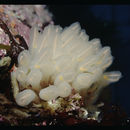Look Alikes
provided by Invertebrates of the Salish Sea
How to Distinguish from Similar Species: The large size and bulblike shapes of the zooids with their two bright pink lines are distinctive of this species. Clavelina sp has no pink lines and the margins of the apertures are lobed. A similar species, Clavelina lepadiformis, occurs in Europe.
- license
- cc-by-nc-sa
- copyright
- Rosario Beach Marine Laboratory
Habitat
provided by Invertebrates of the Salish Sea
Rocky intertidal ledges and vertical surfaces on the open, exposed coast or in currents.
- license
- cc-by-nc-sa
- copyright
- Rosario Beach Marine Laboratory
Distribution
provided by Invertebrates of the Salish Sea
Geographical Range: British Columbia to San Diego, CA. Very common intertidally in Monterey Bay.
- license
- cc-by-nc-sa
- copyright
- Rosario Beach Marine Laboratory
Habitat
provided by Invertebrates of the Salish Sea
Depth Range: Intertidal to 30 m depth. Mostly subtidal north of Monterey Bay.
- license
- cc-by-nc-sa
- copyright
- Rosario Beach Marine Laboratory
Comprehensive Description
provided by Invertebrates of the Salish Sea
This social ascidian has individual, flattened zooids which are much taller than wide. The tunic is clear or translucent and is not coated with sand. The pharynx is not pigmented as a whole, but the dorsal lamina and endostyle are pigmented bright pink, making two distinct pink lines like the filaments of a light bulb up the sides of the zooid. The margins of the atrial and oral apertures are not lobed. Individual zooids up to 5 cm tall and 1 cm wide; zooids form clusters up to 50 cm across.
- license
- cc-by-nc-sa
- copyright
- Rosario Beach Marine Laboratory
Comprehensive Description
provided by Invertebrates of the Salish Sea
Biology/Natural History: The zooids of this species are more closely attached to other zooids when young but may be mostly separate as adults. This species is annual, is most abundant in summer and early fall, and disintegrates in late fall. A few zooids may be found in the winter. Bright orange larvae are brooded in the atrial siphon during the summer. This shape, large size, and clarity of the tunic make this species a good one for studying tunicate structure and feeding. The pharyngeal basket fills the upper, expanded portion and the stomach, intestine, heart, and gonads are in the narrow stalk. The species is hermaphroditic: Usually an orange ovary surrounded by white testes can be seen in the stalk. Look along the edges of the cluster for transparent stolons creeping outward. This is where new buds are being formed. The amphipod Polycheria osborni may be found within the tunic.
- license
- cc-by-nc-sa
- copyright
- Rosario Beach Marine Laboratory

